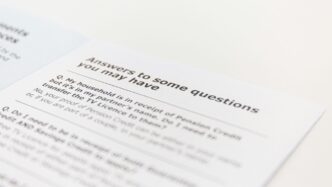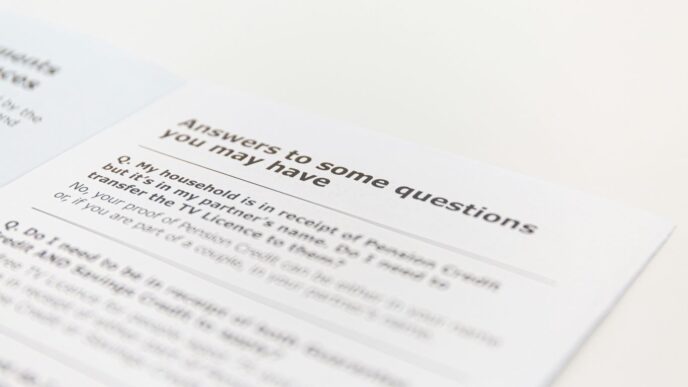Getting your foot in the door for a new job often starts with that initial introduction. It’s your chance to make a good first impression, and honestly, it can feel a little daunting. You want to sound professional, sure, but you also want to show who you are beyond just a resume. This guide breaks down how to craft a solid 1 minute self-introduction job interview sample that really works.
Key Takeaways
- Your introduction is your first impression, so make it count. Aim for about a minute to share who you are and what you bring to the table.
- Structure your intro using a simple formula like Present-Past-Future or ICAAN+ to keep it organized and easy to follow.
- Highlight skills and achievements that directly relate to the job you’re applying for, using language from the job description.
- Practice your intro out loud, maybe in front of a mirror, to sound natural and confident, not like you’re reading a script.
- While professionalism is key, don’t be afraid to add a small personal touch that makes you relatable and memorable.
Crafting Your Concise 1 Minute Self-Introduction Job Interview Sample
Your opening statement in a job interview is your first real chance to make a good impression. It’s not just about saying your name; it’s about setting the stage for the entire conversation. Think of it as your personal billboard, but in spoken word. You want to grab their attention quickly and give them a clear picture of who you are professionally, without rambling on for too long. The goal is to be memorable for all the right reasons.
Understanding the Purpose of Your Introduction
This initial introduction serves a few key purposes. First, it helps the interviewer get a quick snapshot of your background and relevant experience. They might have your resume, but hearing you summarize your journey and highlight what you consider most important gives them a different perspective. It’s also your opportunity to show you’ve done your homework and understand what the role entails. Finally, it’s a way to start building rapport. By showing a bit of your personality alongside your professional qualifications, you can make the interview feel more like a conversation and less like an interrogation. It’s about showing them what it might be like to work with you.
Balancing Professionalism and Personality
Finding that sweet spot between being professional and showing your personality can feel tricky. You don’t want to sound like a robot reading from a script, but you also don’t want to overshare or get too casual. The trick is to weave in elements that make you unique while keeping the focus on your suitability for the job. Think about sharing a brief anecdote or mentioning a passion that, while not directly work-related, demonstrates a skill or trait that’s beneficial for the role. For instance, if you’re applying for a project management position, mentioning that you organize local community events in your spare time could highlight your organizational and leadership abilities. It’s about showing you’re a well-rounded individual who can bring more than just technical skills to the table. You want to give them a sense of your work style and how you might fit into the team dynamic. It’s a chance to show you’re not just qualified on paper, but also a good cultural fit.
Setting the Tone for the Interview
Your introduction really does set the tone for everything that follows. A confident, well-prepared opening can make the interviewer feel more at ease and more interested in what you have to say. Conversely, a hesitant or unfocused introduction can create a less positive atmosphere. It’s your chance to convey enthusiasm for the role and the company. By clearly articulating why you’re interested and what you bring to the table, you signal that you’re engaged and ready to discuss how you can contribute. This initial impression can influence how the interviewer perceives your answers to subsequent questions. It’s like the opening act of a play; it needs to be strong to draw the audience in. Making a good first impression helps build momentum for the rest of the interview, making it easier to connect with the interviewer and showcase your strengths. It’s also a good way to subtly steer the conversation towards the aspects of your experience you want to emphasize, ensuring the interviewer hears about your most relevant qualifications early on. You can even use this as an opportunity to show your understanding of the company’s social media presence and how you might contribute to it.
Structuring Your Impactful Self-Introduction

So, you’ve got that interview coming up, and you’re wondering how to kick things off? Your introduction is more than just saying your name; it’s your opening statement, your chance to make a good first impression. Think of it as setting the stage for the whole conversation. It’s where you briefly show who you are, what you’ve done, and why you’re interested in this particular job. Getting this right can really make a difference in how the rest of the interview flows.
The Present-Past-Future Formula
This is a pretty straightforward way to organize your thoughts. You start with where you are now, then touch on your relevant past experiences, and finally, you look ahead to what you hope to do in the future, ideally with this company. It’s like a mini-story of your career journey. For example, you could say, "Currently, I’m a [Your Job Title] at [Your Company], where I focus on [Key Responsibility]. Before that, I spent [Number] years at [Previous Company] honing my skills in [Relevant Skill]. I’m really excited about this opportunity at [Company Name] because I’m looking to [Future Goal related to the job]."
The ICAAN+ Formula for a Comprehensive Overview
This one’s a bit more detailed, aiming to cover more ground. ICAAN stands for: Identify yourself, Connect your past experience, Achievements, Aspirations, and Next steps. The ‘+’ can be for anything extra you want to add, like a key skill or a personal trait. It’s a way to make sure you’re hitting all the important points. You might start with "I’m [Your Name], and I’ve been working in [Your Field] for [Number] years." Then, you’d move into a specific achievement, like "In my last role, I successfully [Quantifiable Achievement], which I believe aligns well with the needs of this position." Finally, you’d talk about your aspirations, "I’m eager to bring my [Skill] to a company like [Company Name] that’s known for [Company Value or Project]."
Highlighting Key Achievements and Skills
No matter which structure you choose, the goal is to make it count. Don’t just list your duties; talk about what you accomplished. Did you save the company money? Improve a process? Lead a successful project? Quantify these whenever possible. For instance, instead of saying "Managed social media," try "Grew social media engagement by 25% in six months." Also, weave in the skills that are most relevant to the job description. If they’re looking for someone with strong communication skills, mention a time you used those skills effectively. It’s about showing, not just telling, and making sure your introduction gives them a clear picture of your capabilities. You can even check out resources on how to integrate technology into your business to see how proactive people are thinking about their future.
Essential Elements for Your Job Interview Sample
So, you’ve got this minute to make a good impression. It’s not just about saying your name and what you do; it’s about giving them a little snapshot of why you’re the right person for the job. Think of it as your opening act. You want to start strong, show them you can handle challenges, and make it clear you’ve thought about how you fit into their company.
Starting with a Strong Greeting
First things first, a friendly "Hello" or "Good morning/afternoon" goes a long way. Then, state your name clearly. After that, you can jump into your professional identity. Something like, "I’m [Your Name], and I’m a [Your Job Title/Profession] with X years of experience in [Your Field]." This immediately tells them who you are and what you bring to the table. It’s a simple way to get your foot in the door.
Showcasing Problem-Solving Abilities
Companies want people who can fix things when they go wrong. So, briefly mention a time you tackled a problem. You don’t need a long story, just a quick example. For instance, "In my last role, we faced a sudden drop in customer engagement. I analyzed the data, identified the issue, and implemented a new content strategy that boosted engagement by 15% within a month." This shows you’re proactive and can deliver results.
Connecting Career Goals with Company Vision
This is where you show you’ve done your homework. After you’ve talked about yourself, link it to them. Say something like, "I’m really drawn to [Company Name]’s commitment to [Company Value or Goal], and I’m eager to contribute my skills in [Your Skill] to help you achieve [Specific Company Objective]." It shows you’re not just looking for any job, but this specific job, because your goals line up with theirs.
Refining Your Delivery for a Memorable Introduction
So, you’ve got your intro mostly written, but how do you actually say it without sounding like a robot reading a script? That’s where refining your delivery comes in. It’s not just about the words; it’s about how you present them. Think of it as the packaging for your amazing message.
The Importance of Non-Verbal Communication
Did you know a huge chunk of what you communicate isn’t even spoken? Your body language, your tone of voice – it all adds up. If you say you’re excited about a job but your voice is flat and you’re slumped over, that’s a mixed signal. You want your body to back up your words. Good posture, making eye contact (without staring, of course), and a friendly tone can really make you seem more approachable and confident. It’s about making sure your message lands the way you intend it to. Practicing your intro in front of a mirror can help you see what you’re projecting, and maybe even get some feedback from a friend or family member. It’s a good idea to check out some resources on effective communication to get a better feel for this.
Practicing for Confidence and Brevity
Nobody likes a rambling speaker, especially in a job interview. You’ve got a limited time to make a good impression, so keeping it tight is key. Practice your introduction until it feels natural, not forced. This doesn’t mean memorizing every single word, but rather getting comfortable with the flow and the main points you want to hit. Aim for clarity and conciseness. Think of it like an elevator pitch – you want to get your main message across quickly and effectively. If you find yourself going on too long, try cutting out any details that aren’t directly relevant to the job you’re applying for. It’s better to leave them wanting more than to bore them with too much information.
Avoiding a Robotic or Over-Rehearsed Delivery
While practice is super important, you don’t want to sound like you’re reciting a poem. The goal is to sound natural and genuine. If you’ve practiced too much and it sounds stiff, try to loosen up. Maybe focus on the meaning behind your words rather than just the words themselves. Injecting a bit of your personality can make a big difference. Remember, they want to get to know you, not just hear a pre-written speech. A little bit of natural variation in your tone and pace can make you sound much more engaging and less like you’re just going through the motions. It’s a balance, for sure, but finding that sweet spot between prepared and personable is what makes an introduction truly memorable.
Tailoring Your 1 Minute Self-Introduction Job Interview Sample

Your introduction isn’t just a formality; it’s your chance to make a strong first impression and set the stage for the rest of the interview. Think of it as a preview of what makes you a great fit. The key is to make it specific to the job you’re interviewing for. Generic introductions can fall flat, but tailoring your message shows you’ve done your homework and are genuinely interested.
Aligning with Job Descriptions and Company Culture
When you look at the job posting, you’ll see what the company is really looking for. What skills do they mention over and over? What kind of person do they seem to want? Try to weave those exact words and ideas into your introduction. If the job description talks a lot about teamwork, for example, you’ll want to mention your experience working with others. Similarly, if the company culture seems really focused on innovation, you might want to highlight a time you came up with a new idea. It’s about showing them you’re not just looking for any job, but this job, and that you’ll fit right in. It’s like picking out the best outfit for a specific event; you want to look and feel appropriate for the occasion. This shows you understand what they need and how you can meet those needs. You can even check out their website or social media to get a feel for their vibe. For instance, if they have a lot of posts about community involvement, mentioning your own volunteer work could be a good move. It’s all about making that connection. You can find out more about how to research companies on company career pages.
Using Relevant Terminology from the Job Posting
This is where you really show you’ve paid attention. Go through the job description and pull out keywords and phrases that describe the responsibilities and required qualifications. Then, try to naturally incorporate these into your self-introduction. If the posting mentions
Adding Personal Touches to Your Introduction
Beyond just listing your job history and skills, adding a personal touch can really make your introduction memorable. It’s about showing them you’re a real person, not just a resume. Think about what makes you tick, what you’re passionate about outside of work, and how that might actually benefit the company. It’s not about oversharing, but about finding those little bits that connect you to the role or the company’s values.
Sharing Relevant Hobbies or Interests
Sometimes, a hobby can show off skills that aren’t obvious from your work experience. For example, if you’re into competitive chess, that shows strategic thinking and planning. Or maybe you volunteer at an animal shelter; that can highlight your compassion and commitment. These aren’t just random facts; they’re opportunities to demonstrate character traits that employers often look for. It’s about finding that sweet spot where your personal life intersects with professional qualities. For instance, mentioning you’re part of a local hiking group might subtly suggest you’re good at teamwork and perseverance, especially if you talk about tackling challenging trails together. It’s a way to show you’re a well-rounded individual who brings more than just technical skills to the table. You can learn more about making a good first impression at your first impression.
Mentioning Accomplishments Beyond Your Resume
Your resume is great, but it can’t capture everything. Did you recently complete a challenging personal project, like building a website from scratch or learning a new language? These kinds of accomplishments show initiative and a drive to learn. You could say something like, "Outside of my professional work, I recently taught myself Python and built a small app to help organize my personal finances. It was a great learning experience that reinforced my problem-solving abilities." This kind of detail can really make you stand out.
Creating a Relatable and Memorable Connection
The goal here is to create a connection. Think about what you’ve done that might resonate with the interviewer or the company’s mission. Maybe you’re passionate about sustainability, and the company has a strong environmental focus. You could mention, "I’m really drawn to [Company Name]’s commitment to sustainability, as it aligns with my personal efforts to reduce waste in my own community." This shows you’ve done your homework and genuinely connect with their values. It’s these little personal threads that can weave a stronger, more memorable impression, making you more than just another candidate.
Wrapping It Up
So, that’s the rundown on making a good first impression with your intro. Remember, it’s not about reciting your whole life story. It’s about giving them a quick, clear picture of who you are professionally and why you’re a good fit for this specific job. Practice it a bit, keep it focused, and let your personality show through. A solid introduction can really set a positive tone for the rest of the interview, making it easier for both you and the interviewer to have a good conversation. You’ve got this!
Frequently Asked Questions
How should I start introducing myself in a job interview?
Start by saying your name and what you do now, like your job title or if you’re a student. Then, talk a little about your past jobs or schoolwork that are important for this new job. Finish by saying what you hope to do next and why this specific job is a good fit for your future plans.
How can I make my self-introduction stand out?
Think about what makes you a good fit for the job. Mention a few key skills or experiences that match what the company is looking for. Also, try to show your personality a bit so they can see what it’s like to work with you. It’s about being professional but also friendly.
How long should my self-introduction be?
It’s best to keep your introduction to about 1 to 2 minutes. This is just the beginning of the interview, so you want to be clear and interesting without talking too long. Think of it like a quick summary of why you’re a great candidate.
How can I avoid sounding robotic when I introduce myself?
Practice your introduction out loud, maybe in front of a mirror or with a friend. This helps you sound more natural and confident, not like you’re just reading from a script. Knowing what you want to say will make you feel more relaxed.
Can I share personal hobbies or interests in my introduction?
You can mention a hobby or a personal interest if it shows a skill that’s useful for the job. For example, if you’re applying for a job that needs teamwork, you could mention playing a team sport. It makes you more memorable and shows another side of you.
Should I change my introduction for different jobs?
Yes, definitely! Look closely at the job description and learn about the company’s values. Then, adjust your introduction to highlight the skills and experiences that match what they need. Using words from the job posting can also show you’ve done your homework.














